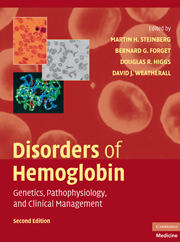Book contents
- Frontmatter
- Contents
- List of Contributors
- Foreword, by H. Franklin Bunn
- Preface
- Introduction, by David J. Weatherall
- SECTION ONE THE MOLECULAR, CELLULAR, AND GENETIC BASIS OF HEMOGLOBIN DISORDERS
- SECTION TWO PATHOPHYSIOLOGY OF HEMOGLOBIN AND ITS DISORDERS
- SECTION THREE α THALASSEMIA
- SECTION FOUR THE β THALASSEMIAS
- SECTION FIVE SICKLE CELL DISEASE
- 19 Clinical and Pathophysiological Aspects of Sickle Cell Anemia
- 20 Sickle Cell Pain: Biology, Etiology, and Treatment
- 21 Hemoglobin SC Disease and Hemoglobin C Disorders
- 22 Sickle Cell Trait
- 23 Other Sickle Hemoglobinopathies
- SECTION SIX OTHER CLINICALLY IMPORTANT DISORDERS OF HEMOGLOBIN
- SECTION SEVEN SPECIAL TOPICS IN HEMOGLOBINOPATHIES
- SECTION EIGHT NEW APPROACHES TO THE TREATMENT OF HEMOGLOBINOPATHIES AND THALASSEMIA
- Index
- Plate section
- References
21 - Hemoglobin SC Disease and Hemoglobin C Disorders
from SECTION FIVE - SICKLE CELL DISEASE
Published online by Cambridge University Press: 03 May 2010
- Frontmatter
- Contents
- List of Contributors
- Foreword, by H. Franklin Bunn
- Preface
- Introduction, by David J. Weatherall
- SECTION ONE THE MOLECULAR, CELLULAR, AND GENETIC BASIS OF HEMOGLOBIN DISORDERS
- SECTION TWO PATHOPHYSIOLOGY OF HEMOGLOBIN AND ITS DISORDERS
- SECTION THREE α THALASSEMIA
- SECTION FOUR THE β THALASSEMIAS
- SECTION FIVE SICKLE CELL DISEASE
- 19 Clinical and Pathophysiological Aspects of Sickle Cell Anemia
- 20 Sickle Cell Pain: Biology, Etiology, and Treatment
- 21 Hemoglobin SC Disease and Hemoglobin C Disorders
- 22 Sickle Cell Trait
- 23 Other Sickle Hemoglobinopathies
- SECTION SIX OTHER CLINICALLY IMPORTANT DISORDERS OF HEMOGLOBIN
- SECTION SEVEN SPECIAL TOPICS IN HEMOGLOBINOPATHIES
- SECTION EIGHT NEW APPROACHES TO THE TREATMENT OF HEMOGLOBINOPATHIES AND THALASSEMIA
- Index
- Plate section
- References
Summary
INTRODUCTION
HbC (HBB glu6lys), along with HbS (HBB glu6val) and HbE (HBB glu26lys), is one of the three most common hemoglobin variants in humankind. Its positive charge that allows it to bind the erythrocyte membrane, and perhaps other unique features of this variant, lead to loss of cell K+ and water, thereby increasing erythrocyte density. HbC disease, defined as homozygosity for the HbC gene, causes mild hemolytic anemia; simple heterozygosity for HbC (HbC trait, HbAC) is innocuous. In HbSC disease, in which the erythrocyte concentration of HbS and HbC is nearly equal, the dehydrated, dense erythrocyte accentuates the deleterious properties of HbS by producing a milieu favoring HbS polymerization. HbSC disease causes vasoocclusive disease and hemolytic anemia, albeit on average both less severe than found in sickle cell anemia (homozygosity for HbS). Like sickle cell anemia, the hematological and clinical features of HbSC disease are heterogeneous, but all of the complications that make sickle cell anemia notorious can be present; some even appear more often in HbSC disease.
HbC and HbC Disease
Origins, Selection, and Distribution of HbC
HbC, the second hemoglobin variant discovered, was described in 1950, and the first homozygous case was reported in 1953. The βC-globin gene contains a GAG→AAG transition and codes for lysine instead of glutamic acid. Shortly after its description in African Americans, HbC was found to be common in Africa.
- Type
- Chapter
- Information
- Disorders of HemoglobinGenetics, Pathophysiology, and Clinical Management, pp. 525 - 548Publisher: Cambridge University PressPrint publication year: 2009
References
- 4
- Cited by



